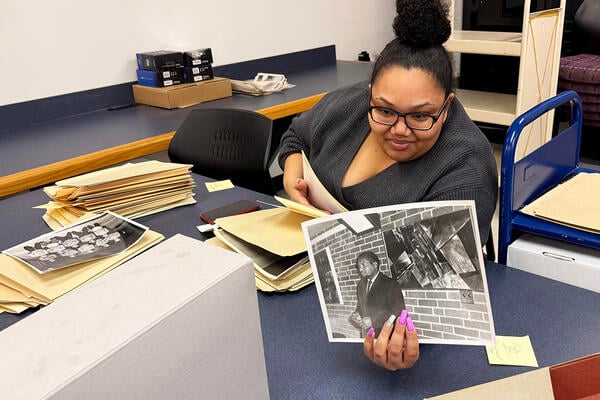For the past two years, during the twilight of my academic career, I have become a devotee of the fountain pen, often pondering this seemingly retro act of putting pen to paper.
Composing again by hand forced me to admit how often I succumb to the internet’s never-ending temptations. In the past, some of my best prose has come forth at 40,000 feet, while I was strapped in for a long flight—with no contact outside the streaking metal tube. But the wily digital devil never rests. Most jets now offer Wi-Fi, enticing you to check your email or the Yankees–Red Sox score as you cross the North Atlantic.
My longing to write by hand, though, was undermined by largely illegible penmanship, a lifelong consequence of my naturally lefty self having been forced to write right-handed. No pen ever seemed to work for me, and I have tried most. Gel pens are the worst, producing a script that even I cannot decipher. Even so, during a research trip to Europe in fall 2022, where Wi-Fi was often unavailable, I found myself relying on a bound notebook during the day and my computer at night. The illegibility of my notes and journal entries made typing them out especially onerous and time-consuming, all the more so after I had returned home two months later. Then I remembered a fountain pen that my mother had gifted me so long ago—was it for my 50th birthday in 2005?—that its ink cartridges had dried up. A trip to Staples yielded a small pack, and I realized right away that there was enough friction between the nib and page to slow me down—enough for me to be able to decipher what I had written.
Like most brainstorms, this one proved ephemeral. To write by hand and then enter text into a computer—with my mediocre keyboarding skills—was just too burdensome. Those who started their academic journeys during the typewriter era will remember with a whiff of despair those late-night, hours-long sessions spent typing the final draft. Correction tape, erasable bond, Wite-Out—my heart sinks just listing those essential tools from another era. If you want a taste of those times, just sample the acknowledgments in academic books or dissertations from the decades before computers, in which women, typically wives, are thanked for having typed the manuscript. The acknowledgements from Sacvan Bercovitch’s The American Jeremiad, which I just pulled from a shelf, reflect more rarefied academic circumstances, as the author notes the grant provided by the English Department at Columbia University “for the typing of the manuscript.”
And then a light went off as I sat in my study, one that has changed my life as a writer. After struggling with incipient carpal tunnel syndrome a few years ago, I purchased voice recognition software. Dragon Naturally Speaking was powerful, especially if you spoke in complete phrases and sentences. My copy of the software is now old—it will not work with Windows 11—but proved a godsend with unexpected benefits. While dictating my notebook pages, I could hear the awkward sentences; I could conjure the better word on the spot, and I could detect those places where the tone needed adjusting. Sometimes inspiration would bless me and a new sentence or two would emerge like Athena.
I’m no neo-Luddite longing to smash all computers, even when Windows or MS Word betray me, as they so often do. I recognize the realities and benefits of our digital age. But wielding a fountain pen these past two years has prompted me to wonder whether some challenges the humanities face regarding writing and reading might be overcome by heeding the pen’s simple lessons.
The Importance of Touch
For millennia the act of writing has been tactile. From Babylonian cuneiform on clay tablets to elaborate Medieval script on vellum and modern calligraphy on heavyweight wedding stationery, writing has always meant touching the surface, with words being physically imprinted as the pen journeys across. When I write well, my hands seldom leave the page. And when I stop to consider the right word or a more felicitous phrase, my pen often poises a mere quarter inch above, ready to strike.
Compare this to composing on a laptop, where pauses can lead to disaster. Distractions fill your field of vision—apps, task bars, weather forecasts and seemingly never-ending notifications that another email has arrived or another appointment looms. When you grasp for the right combination of words, it’s all too easy to seek them beyond the screen, or, even worse, to succumb to the program suggesting what it believes should come next. And unless you are vigilant about shutting off endless features, the software will insist upon indicating that you just misspelled a word or used a questionable grammatical construction. Most of us then dutifully correct the “mistake,” only to lose the rhythm and even essence of our prose. More and more, the virtual page seems to be doing the writing.
The Value of Tangibility
We have all had the experience of composing and revising a document on a computer only to lose the effort because of a crash, a software freeze or a moment of forgetfulness in which we clicked “no” instead of “yes.” What might have seemed so real to us for an hour or more vanishes like a genie who returns to his bottle without granting our wish.
When I compose by hand, my efforts are right in front of me. The crossed-out word—which turns out to be the right one—can still be recovered. The history of moving paragraphs, those arrows and circles that sometimes fill the page, are not lost as they would be in computer drafting. Even more satisfyingly tangible for me, however, is the physical evidence of my labors: the blue ink stains on my right hand, the ritual of refilling my pen from the bottle when I have gushed out a pool of words, the celebratory occasion when I empty a bottle of ink and need to open a new one. A similar mood of celebration arises when I fill the last page of my wide-ruled notebook and place it on the shelf next to its predecessors. Scrolling through thousands of documents and folders on my computer is certainly a humbling experience, as they represent the literal steps in a multidecade academic journey, but I regret not having found my fountain pen niche many years before. What a collection those notebooks would’ve been.
The Pleasures of Portability
Coinciding with my return to compositional roots has been my regular presence at a place where my words seem to flow so easily, the Hall Street Bakery in Grand Rapids. During my sabbatical, I was there at least five days a week and now continue to show up on nonteaching days. All I need is my notebook, a folder with ideas or drafts, a full pen and my regular—a large house coffee and a cranberry-almond scone—to set me up for a solid hour of writing. Conversations bubble from nearby tables, kids run around hopped up on sugar, drivers retrieve DoorDash orders—all set against the occasional counterpoint of the hissing espresso machine—and I am in my element. No need for Wi-Fi passwords or the elusive table next to an electrical outlet. I can walk across the room to speak with someone, order a refill, visit the men’s room—all without fearing that my laptop will disappear. And spilling coffee on my notebook or dropping it onto the floor is a minor inconvenience, not an expensive technological catastrophe. Traveling light, I can sweep up my possessions in an instant and head out the door.
The Relevance to Reading
In thinking about writing as a physical act that produces something you can hold, I recognized anew how relevant these same qualities are to reading. We seem today to be awash in words, yet paradoxically find ourselves in the midst of a reading crisis that extends from the youngest learners to those at America’s universities.
An article by Rose Horowitch in The Atlantic, “The Elite College Students Who Can’t Read Books,” convinced me that my experience with the fountain pen might be relevant to the challenges she describes.
Horowitch reports that students at elite colleges, who have already proven their ability to read complex texts, seem less and less able (or willing) to read long literary works. She mostly ascribes this to high schools emphasizing standardized tests, to teens distracted by smartphones and to college students who view their educations in strictly transactional terms, as means to specific, often exceedingly specific, ends—which seldom include pushing through Middlemarch.
She may be right, but the teachers and faculty she interviewed offer little beyond assigning shorter texts: Kate Chopin’s The Awakening instead of Jane Austen’s Pride and Prejudice. Toni Morrison’s The Bluest Eye instead of Ralph Ellison’s Invisible Man. A book or two at most from The Iliad or Paradise Lost.
Let me argue, though, that the very elements I associate with composing by hand—its tactile and tangible nature, its simple conveniences—should be drawn upon when encountering long, complex and sometimes life-changing texts. And that the cool distance of the digital interface works against these very qualities.
Yes, I know it is possible to put all your books on a single device where you can search and annotate the texts. Even if you lose your Kindle, your digital library can be retrieved from the cloud. Yet the experience of reading on the screen tends to flatten all writing, making each screen much like any other, so that the unique feel and heft of Moby-Dick, for example, is lost, making Melville’s incandescent prose indistinguishable from any Substacker’s, and probably less visually enticing.
Even if you can resist distraction on your laptop, you never get the sensory experience unique to each book: how it feels in your hands, how its page design pulls you in or pushes you away, how its very smell when brand-new or decades old can evoke its distinctive qualities, how the satisfying sound of turning pages reaches a crescendo when you get to the end and close the cover with a resonant thump. Like the angry slam of a telephone receiver, it’s a sound beyond our digital age. And it all leads to a final moment when you place the book on a shelf to stand as a tangible reminder of your ever-changing reading life—no internet connection required.
The physical book, that container that our society, try as it might, cannot cast into the electronic darkness, will live on. At least I hope so. A recent visit to my university’s beautiful library leaves much room for doubt. In the popular Mary Idema Pew Library Learning and Information Commons—sorry, but that’s its official name, sans commas—hundreds of students gather at any given time. But to stroll through its busy floors soon makes this book lover feel like Diogenes in search of an honest man. My lamp has seldom shined upon a student with a physical book in hand; instead, they tap and scroll their way through reading assignments in much the same way they engage daily life.
I see them as we share the bus that travels between our university’s two campuses, filling each moment with the small screens they find far more interesting than the passing world—the season’s first snowflakes, the glow cast upon the road as dusk approaches, the deer in a harvested cornfield who look up with more curiosity than my fellow travelers.
With a sigh—and nod to the deer—I open my copy of Uncle Tom’s Cabin, touching its familiar pages with my ink-stained hands, and try to remember to text my wife that I’m on my way.








